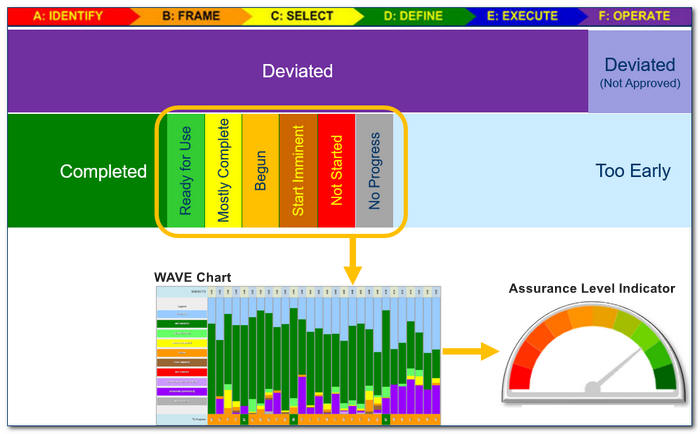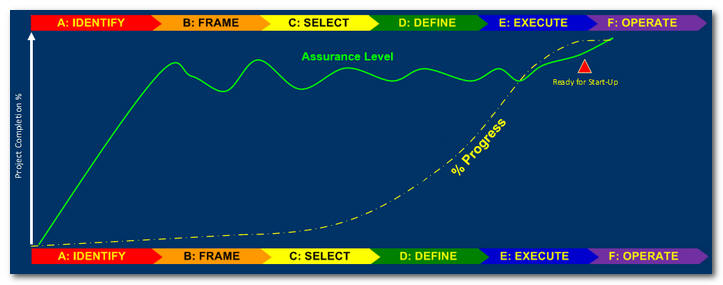|
|
|
|
Assurance
Definition The definition given below, clarifies that reference: In the context of the OR&A™ process, assurance refers to the act of providing confidence to the various stakeholders in a project or venture that both their asset and supporting organisation has achieved a state of 'Readiness to Operate', (or that it will be able to do so by the time the acceptance / handover to the Operations Team occurs). The methodology used and the way this is disseminated is described in some detail on this page.
Providing Assurance of 'Ready
to Operate' Status This is made clear by the definition below (reproduced from the OR&A™ process) which defines the term 'Operations Readiness' and what this means for the continued operation of an asset after start-up: The process of preparing the custodians (owner/operator) of an asset under construction (and the supporting organisation) such that, at the point of delivery/handover, that organisation is 'Ready to Operate', (i.e. is fully prepared to assume ownership of the asset, accepts responsibility for, and is capable of, performing the efficient operation of that asset, in a safe, sustainable and environmentally friendly manner). By default, this includes participation in the activities of the Project Team to ensure the needs of the Asset Operations Team (to enable them to implement this process) are recognised and addressed during the development of the asset.
Measuring Assurance
Calculation of Current Assurance Level
Calculation of Current Assurance Level The methodology used to calculate and display the current real-time assurance level involves the following logical steps:
This process occurs continuously, with all input to the system updated instantly, meaning all users can see the current status irrespective of their physical location (i.e. anywhere they can access the internet).
Comparing Apples with Apples The answer is quite simple, the OR&A™ Solution is NOT a Project Management Tool. It is a system dedicated to ensuring that the input from Operations is considered at every stage of a project. Their involvement can be explained by three simple statements which identify the reason for using an OR&A™ process: 1. Project Deliverables Most (almost all) of the deliverables required by Operations are specified in the EPC Contract and are therefore managed and delivered by the Project Team; 2. Operations Requirements, advice & contributions (from OR A, aligned to the Project Plan) The involvement of the OR&A Team in Project activities, such as. checking operability, maintainability, reliability and availability data, reviews and output of design, confirming modes of operation of equipment, participation in HAZID, HAZOP, FAT, SAT, punch-listing, commissioning & start-up activities; 3. Operations needs that are not Project deliverables The readiness of the Operations Team, ISSOW implementation, rationalisation of long term spare parts, training and competence of Operations Team and Operations, Management Systems etc; So far as an S-Curve is concerned, the output from the OR&A™ Solution will not produce an S-Curve but rather a 'sine-wave' which indicated the calculated readiness status as the project progresses, as illustrated below:
OR&A™ Assurance Level vs. Project S-Curve The graph shows a typical Project S-Curve which effectively shows a steady increase in %Progress as defined by the Value of Work Done (VOWD) leading to the point at which the EPC Contractor declares the asset as 'Ready to Start'. Conversely, and in accordance with the measurement methodology of the Assurance Level described earlier, the Assurance Level, measuring only those OR&A Subjects, Activities and Tasks that are currently in scope, produces a sine-wave of sorts due to the way work comes into scope, progresses to completed status and then is excluded from the measurements. The current value of the Assurance Level, at any point in time (for a healthy project), will vary between 75% and 90% (approximately). Any excursion outside this range would therefore indicate an issue that needs to be further investigated and is therefore a key leading indicator that helps the OR&A Manager identify issues, enabling mitigating action before they have a detrimental effect on the project. |
|
|
© OR&A™ |


